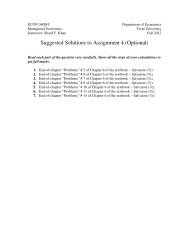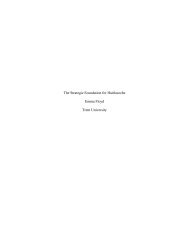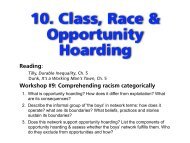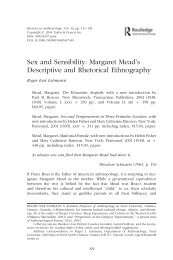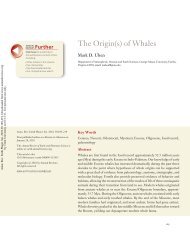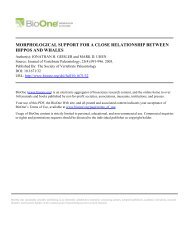REO FORTUNE'S PSYCHOLOGICAL THEORY OF CULTURAL ...
REO FORTUNE'S PSYCHOLOGICAL THEORY OF CULTURAL ...
REO FORTUNE'S PSYCHOLOGICAL THEORY OF CULTURAL ...
Create successful ePaper yourself
Turn your PDF publications into a flip-book with our unique Google optimized e-Paper software.
Fortune’s Theory of Cultural Ambivalence<br />
293<br />
Mead’s squares typology comprised four personality types labeled<br />
Northerner, Southerner, Turk, and fey, that one might simplistically gloss<br />
as egocentric, sociocentric, domineering, and nurturant, respectively. It was<br />
born in the famous conversations among Fortune, Mead, and Bateson in<br />
the Sepik field of New Guinea in 1933, at the same time as an intense<br />
flirtation developed between Mead (Fortune’s wife) and Bateson. This certainly<br />
would have made for bad affective associations in Fortune’s mind,<br />
probably both in waking and in sleep. Beyond this, the characteristics of<br />
the model would make it anathema to his assumptions and preferences,<br />
carefully and logically worked out in researching his dream book.<br />
Fortune realized that the squares system’s classifications were subjective<br />
and bad science when Mead changed her classifications of particular people<br />
depending on the health of her relationships with them. In the intense<br />
emotions and “tropo” psychology that gripped the group in the oppressive<br />
Sepik heat, Fortune struck Mead, following which she miscarried (Banner<br />
2003: 335–6). In her understandable anger, Mead labeled Fortune with<br />
negatively valued, masculine terms from the squares model like possessive,<br />
jealous, and aggressive. Fortune’s behavior at the time doubtless reflected<br />
consternation over the appearance of a charming rival who, in apparent<br />
collusion with his wife, threatened his marriage.<br />
Caroline Thomas (2009, 307) quotes one of Fortune’s letters of 1934 in<br />
which he wrote that when Mead labeled him a sadistic “Northerner,” he<br />
felt himself not only negatively judged, but also the victim of what anthropologists<br />
now call “othering.” I suspect Fortune’s theory of the changing,<br />
conflicted individual vis-à-vis social pressure, and his stance against smug<br />
nationalism, would have biased him against the squares model, even had it<br />
not been used as a weapon against him.<br />
After Fortune’s marriage to Mead ended, Mead published her influential<br />
and groundbreaking Sex and Temperament in Three Primitive Societies<br />
(Mead [1935] 2001). As Gerald Sullivan has pointed out, the idealized<br />
gender types Mead identified in the perfectly contrasting Arapesh,<br />
Mundugummor, and Tchambuli correspond to her squares types:<br />
Mead and Bateson used the same system of categories to compare<br />
various societies; hence the ethos of each of the societies mentioned<br />
in Sex and Temperament should be understood as a representation<br />
of one or more of Mead and Bateson’s types. The men<br />
and women of the Arapesh generally exemplified the maternal, or<br />
Southern, position as those of the Mundugumor generally exemplified<br />
the paternal, or Northern position. Tchambuli women were<br />
usually Turks; Tchambuli men were most often a variation on feys.<br />
(Sullivan 2004, 195)<br />
pacs-32-02-06.indd 293 9/7/2009 2:32:34 PM



